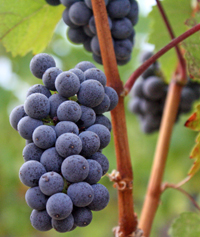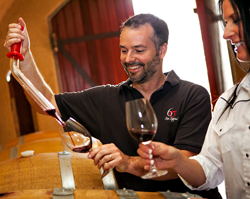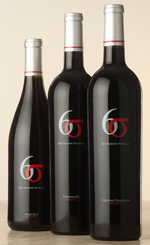Do I drink it now – or wait?
What happens to wine as it ages? Does it always get better? Is there a point when it is past its prime? Or the more practical aspect: Do I drink this now or wait?
One of the most important aspects in truly understanding wine is grasping the concept of wine as an ever evolving, living, breathing creature. Let me explain…
The key players – tannins and anthos
 The “skeleton” of a wine consists of a few key “bones” that play a major role in the way it tastes.
The “skeleton” of a wine consists of a few key “bones” that play a major role in the way it tastes.
One component is tannins. Tannins give a wine length and, to some degree, bitterness; they are also responsible for the drying sensation you feel around the edges of your mouth after you drink the wine. (Other sources of tannins are tea, aspirin, or dry nuts, by the way). The tannins in wine come from the skins and seeds in the grapes. Overall it is fair to say that the more tannins a wine has, the “bigger” the taste.
The other “bone” in the skeleton is anthocyanins. Anthos, as winemakers call them, are the colored pigments in wine. They obviously give red wine its deep purple /black hue and, along with tannins, contribute to the mouth-filling body of a wine. In fact, it is the association over time of tannins and anthos that determines how a wine ages in terms of its mouth-feel and its ability to resist oxygen.
Softening up and getting along.
 From the day wine is made to the time it is consumed, it is undergoing a slow and (hopefully) steady oxidation. When wine is first made, it contains plenty of tannins and anthos extracted from the grapes, but there is no connection or association between the two. This is why the taste of a young wine can be harsh and disjointed, covering up the fruity aromas. As the wine is aged in barrels, it is slowly reacting with the oxygen in the air, and the tannins and anthos bond to form more complex compounds that are softer and more velvet-like. After a year or two, the wine is smooth, ready for bottling.
From the day wine is made to the time it is consumed, it is undergoing a slow and (hopefully) steady oxidation. When wine is first made, it contains plenty of tannins and anthos extracted from the grapes, but there is no connection or association between the two. This is why the taste of a young wine can be harsh and disjointed, covering up the fruity aromas. As the wine is aged in barrels, it is slowly reacting with the oxygen in the air, and the tannins and anthos bond to form more complex compounds that are softer and more velvet-like. After a year or two, the wine is smooth, ready for bottling.
After bottling, the wine is exposed to less oxygen, but it is still slowly developing more complex anthos and becoming more round and full, with more pronounced fruity aromas.
The peak and beyond …
 Wine peaks when the aromas are in full effect and the tannins have complexed to the point of tasting “melted.” For some wines this peak can last for years.
Wine peaks when the aromas are in full effect and the tannins have complexed to the point of tasting “melted.” For some wines this peak can last for years.
The next phase comes as the fruit aromas and taste are surpassed by what winemakers call “bottle bouquet.” This bouquet is comprised of flavors developed in the bottle during aging. An extreme example would be a sherry, but in short we’re talking about earth, dust and oxidized aromas. Wines can still be enjoyable at this stage and at times a real treat with food. However, when the oxidized aromas take over completely and the wine loses its mouth-feel and becomes sour or burning, the game is over.
What does all this mean for your wine cellar?
So how do you navigate all of this? Well, there are no steadfast rules since each wine has its own path. When you are in doubt about a specific wine, my best advice is to call the winemaker and ask. Good examples of age-worthy Six Sigma wines are ’09 Cuvée, ’05 Tempranillo and ’05 Cabernet Sauvignon. I will be happy to pull some corks to give you some insight on other Six Sigma library wines!
Cheers,
Matt


